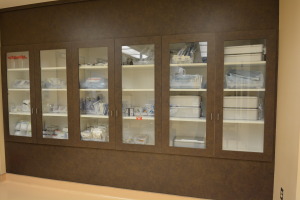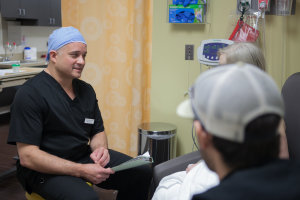Our Surgical Facilities
Our facility was designed exclusively with the needs of tubal surgery patients in mind: privacy, comfort, and individualized care.
We have located our surgical center in one of the most desirable areas of Mid-town Raleigh.
We are located one-half mile from trendy North Hills Mall where patients have immediate walking access to many restaurants and entertainment venues, two pharmacies, and a grocery store. Once our patients check into their hotel private car service will transport patients to and from our facility.
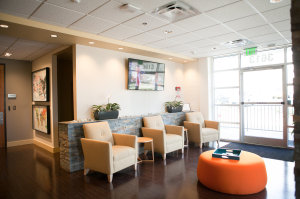 Patient Waiting Room
Patient Waiting Room
Our lobby is comfortable, sunny, and can easily accommodate responsible adults as they wait for surgery to be completed. We have a dedicated beverage bar, private bathrooms, and individual lockers for storage of patient belongings. In addition, we have wireless Internet connection and a large flat screen monitor for patient and guest comfort.
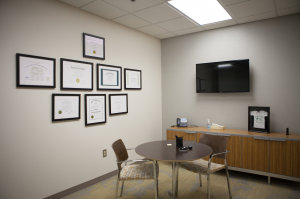 Patient counseling rooms
Patient counseling rooms
We have two dedicated patient counseling rooms where the pre-operative consultation and the post-operative consultation will take place. These rooms have a large flat screen monitor to assist with audio-visuals used for patient education and are sound proof in order to assure patient privacy.
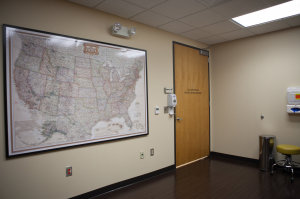 Patient pre-operative waiting room
Patient pre-operative waiting room
Patients enter the pre-operative waiting room with their responsible adult and an attendant nurse. One-on-one nursing is the rule and not the exception at our facility
In the pre-operative waiting room, patients will remain with their responsible adult. This area contains a private bathroom where patients can change into both a patient surgical gown and a comfortable spa like robe. Patients can expect total privacy in this room and they do not share this room with any other patients during their wait for surgery.
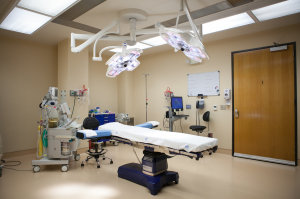 Dedicated tubal surgery operating room
Dedicated tubal surgery operating room
Our operating room was designed exclusively for sterilization reversal and tubal surgery.
It is large and spacious and has ample room for the patient and operating room staff. The operative table and dual overhead halogen lighting are Maquet and are engineered in France. The dual lighting provides ample light for surgery and minimizes the formation of heat.
The room has centralized oxygen supply enough to last for four weeks of normal surgical volume and the vacuum pump system is centralized as well. The anesthesia machine is an Aestiva 5 and is equipped with both isoflurane as well as the more expensive anesthetic agent sevoflurane.
The entire operating room has back up power supplied by a Kohler diesel generator that can provide 8 hours of continuous power in the event of an emergency.
The advantage of having a single spacious room dedicated to infertility surgical is efficiency. Efficiency during surgery can make for more seamless patient flow before, during, and after surgery and can minimize uncomfortable delays and staff and patient anxiety.
All equipment is safely stored in cabinets and no staff has to leave the room in the middle of a surgical procedure to get a necessary item. An additional advantage of having a dedicated single purpose operating room is our patients don’t have to share surgical space with patients who may have contagious illnesses that could contribute to an increased risk of surgical site infections or operative complications.
One unique aspect of our practice is we provide our patients with the ability to have screening laparoscopy during sterilization reversal. Although we do not perform operative laparoscopy in our facility, we do offer patients a minimally invasive surgical modality to determine if their fallopian tubes can be repaired and to diagnose potential sites of tubal blockage. Although we have found we can repair most fallopian tubes, screening laparoscopy offers patients who want more reassurance about the possibility of the success of their procedure more of a guarantee. A major advantage of the screening laparoscopy is patients are offered a partial refund of their surgical fee if tubal repair is not possible.
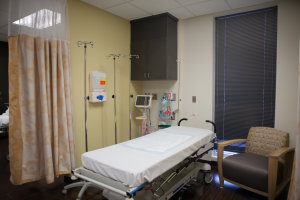 Recovery room
Recovery room
Our recovery room can handle a maximum of three patients; however, we rarely have more than two patients in our recovery room at any one time. There are two stretcher bays in our recovery room divided by a wall for greater patient privacy. Each stretcher bay has centralized oxygen and vacuum if required.
After patients are escorted to the recovery room by the surgical team and anesthesia staff after surgery, they begin Phase One of their surgical recovery. The patient’s responsible adult is allowed to accompany the patient for the remainder of the their stay in our facility. Patients usually remain in Phase One for less than one hour.
After Phase One recovery, patients are expected to dress with assistance, use the restroom, and ambulate to Phase Two, which is a partially isolated area with a reclining chair and a large screen monitor with cable television. Patients remain in Phase Two recovery for less than 30 minutes and are able to discuss their surgical findings and procedure with Dr. Monteith before being discharged to the hotel.
Patients are able to ambulate, often with minimal assistance, to a covered portico where their private car waits to return them to the hotel. Patients are provided Dr. Monteith’s cell phone number and encouraged to call with any questions or problems the night of surgery. Patients return to the office the next day to have an evaluation of their surgical incision and a post-operative consultation with Dr. Monteith.

